Manage Your WhatsApp Message Templates
What is a Message Template?
WhatsApp Message Templates are specific message formats that your business can use to send out notifications, alerts, and customer care messages to people who have opted-in to receive WhatsApp messages. Before it can be sent to your audience using the broadcast feature in Waba Business Dashboard, your message template will be reviewed and should be approved by Facebook.
WhatsApp Promotional Message
WhatsApp is a real game-changer for businesses seeking to deliver an exceptional customer experience. The company recently announced a significant change in its business messaging policy, introducing a promotional message template to Indonesia and Mexico.
WhatsApp overturned these restrictions with the following criteria:
- Businesses must have Indonesia or Mexico as the country setting in Business Manager to be eligible using the feature.
- Businesses must obtain opt-in* from target recipients in advance for sending all proactive notifications, including non-transactional notifications.
The example use cases for promotional messages include:
- Re-engagement: cart abandonment reminder, back in stock alert, time to reorder alert, and a reminder to book an appointment
- Recommendations: upsell and cross-sell product recommendations
- General marketing: promotional offers
Create a New WhatsApp Message Template
- Go to the Message Templates page by clicking from the left side navigation, and click + Create New Message Template on the top right of the page.
- Type in the name of the message template. The name can only be in lowercase alphanumeric characters (a-z, 0-9) and underscore “_”. Space, uppercase letters, and symbols are not allowed.
- Choose a category of your message template. For a non-promotional WhatsApp template message, you can choose any category based on your business needs and objectives. For promotional content, you have to set the category as Marketing.
- You may select the template type in the event that the category you have chosen pertains to marketing.
- Choose the language of your message template. You can select more than one language to create a message template in multiple languages.
- Fill in all the required content fields for the languages you selected (see Message Template Content Structure section to get tips on how to fill the content). Once you fill all the required fields, click Save. Your message template will be reviewed by Facebook, and you can check the status on the Message Template page. In the case of a rejected template message, you may reach out to our support team at support@botika.online.
Template Type
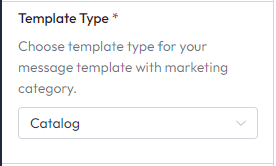
You can choose the type of template you will use if the template category you choose is marketing. There are several template types to choose from:
Custom
This template available for marketing & utility category. With the custom template type, you can create a message template according to your needs while still paying attention to the existing rulesLimited Time Offer
This template only available for marketing category. Limited Time Offer template allow you to display expiration dates and running countdown timers for offer codes in template messages, making it easy for you to communicate time-bound offers and drive customer engagement. There are several special rules for templates with this limited time offer type:- Only allowed to use headers with image and video types
- Must use the limited time offer component
- The maximum character for the body is 600 characters
- It is not permitted to use a footer
- Copy code button component required if 'has_expiration' is set to true. If set to false but want to use a copy code button, it must appear first in the buttons component
- URL button component is always required
Copy Code
This template only available for authentication category. Copy code template allow you to send a one-time password or code to your users. When a WhatsApp user taps the copy code button, the WhatsApp client copies the password or code to the device's clipboard. For more information you can go to message template authentication documentation.One Tap
This template only available for authentication category. One tap template allow you to send a one-time password or code to your users. When a WhatsApp user taps the autofill button, the WhatsApp client triggers an activity which opens your app and delivers it the password or code. For more information you can go to message template authentication documentation.Zero Tap
This template only available for authentication category. Zero tap template allow your users to receive one-time passwords or codes via WhatsApp without having to leave your app. For more information you can go to message template authentication documentation.
Message Template Content Structure
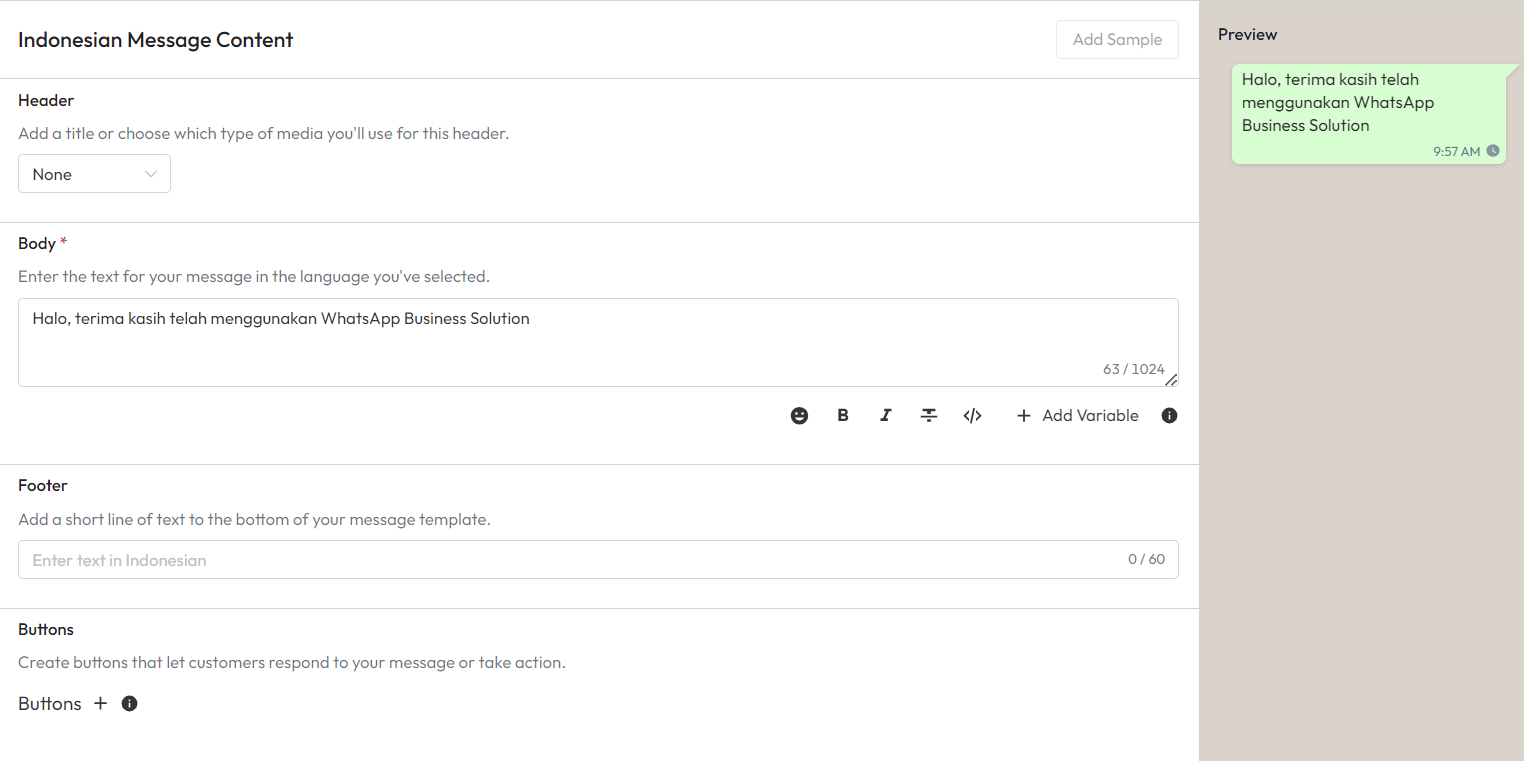
Header (optional)
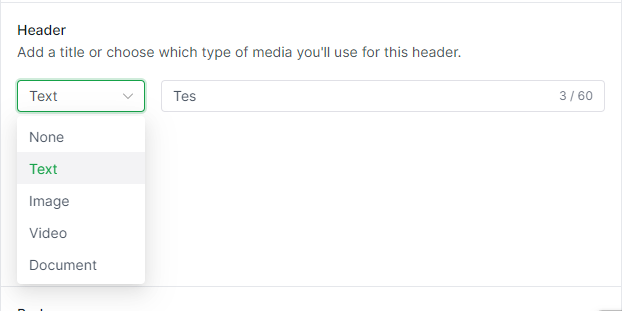
A header can be a text or a media - image, video, or document. For a text header, the character limit is 60 characters and you can add a maximum of one variable (See variable section for more info).
Body

A body is where you add the content of your message. You can edit text formats, add emojis, and add variables (See variable section for more info). The character limit is 1.024 characters for the body section, with only letters, numbers, and emojis allowed. It shouldn’t have newlines, tabs, or more than four consecutive spaces.
Footer (optional)

A footer can be a closing sentence, or default info - such as an address, social media ID, email, etc. - about your company that you want to include in your message. For the footer section, the character limit is 60 characters.
Button (optional)
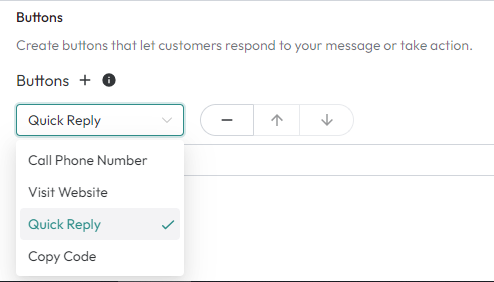
When creating a message template, you can include up to 10 buttons, making it easier for users to respond to or take action on your message.
Quick Reply
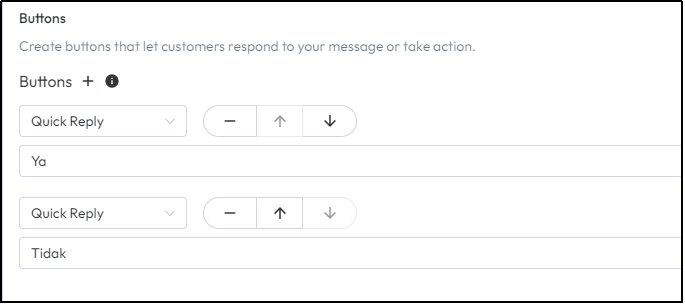
A Quick Reply button allows your customers to reply to messages quickly. For each template, you can use up to 10 Quick Reply buttons. You must define the payload of each button to return the correct reply after the customer presses the button.
If using quick reply buttons with other buttons, buttons must be organized into two groups: quick reply buttons and non-quick reply buttons. If grouped incorrectly, it will return an error indicating an invalid combination.
- Quick Reply, Quick Reply

- Quick Reply, Quick Reply, URL, Phone
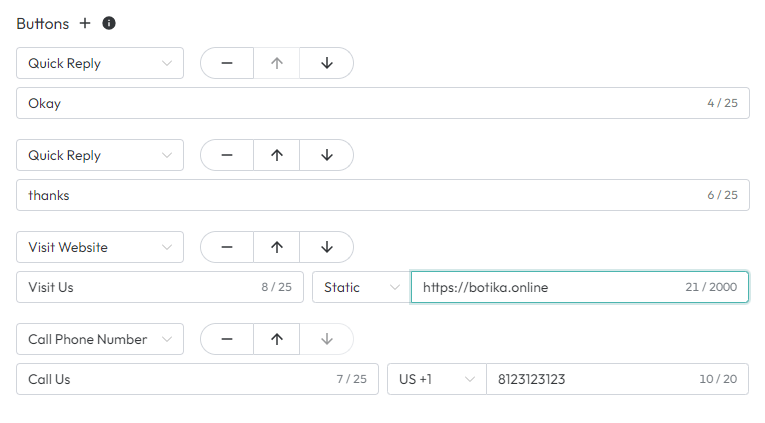
- URL, Phone, Quick Reply, Quick Reply

Examples of invalid groupings:
- Quick Reply, URL, Quick Reply
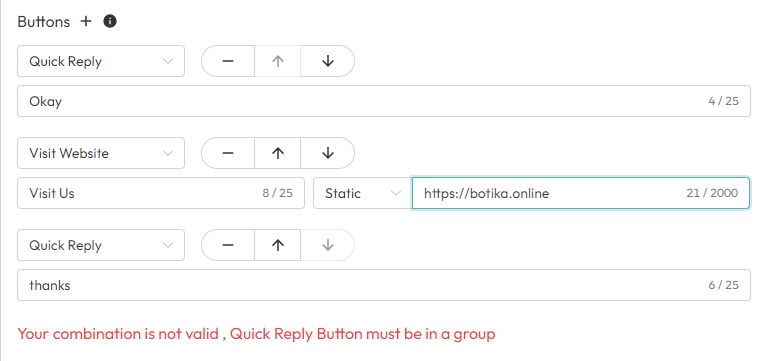
- URL, Quick Reply, URL
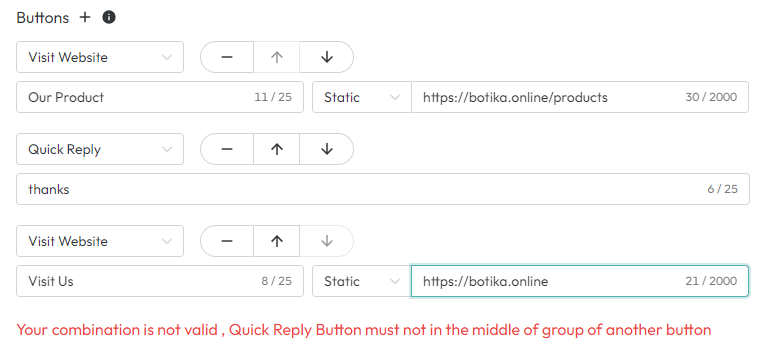
- Quick Reply, Quick Reply
Visit Website
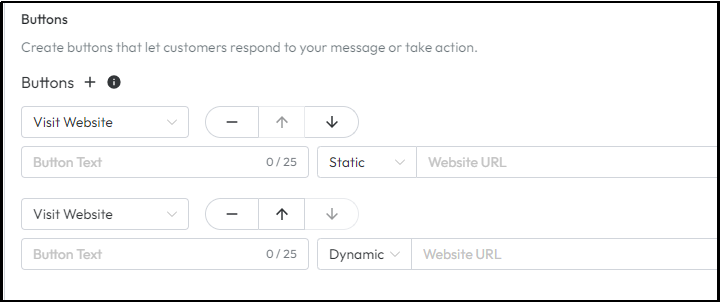
The Visit Website button acts to enter a URL, making it easier for customers to switch from messages to the website. You can use a maximum of two Visit Website buttons by selecting static URL or dynamic URL type. Dynamic URLs let you personalize the website link by having a variable at the end of the link. The use case is for example when you want to inform a tracking order to your audiences.
Call Phone Number

You can include a Call Phone Number button to enter your business telephone number, making it easier for customers to contact your business in one tap.
Copy Code

You can also include a Copy Code button to make it easier for customers to copy the code in your message.
Limited Time Offer (optional)

This component only appears when the template type is Limited Time Offer. In Limited Time Offer component you can fill Offer details text that you make. Maximum character for text is 16 characters. You can also set the promotion you create whether to use an expiration time or not.
Variable
Using variables in your message template is a way to personalize your message to your audience and to reuse your template message for different occasions. A variable is written in two enclosing curly brackets with a number inside a bracket, e.g.: {{ 1 }} It represents changing content and can be implemented in the text header and body content, as well as when you include a dynamic URL button on your message template. Here is an example of using variables in a message:
You can use variables for cases such as when you want to mention your customers’ names, information on price, promoted items, promotion dates, location, etc. The contents for the variables should be provided in the CSV format when creating a new broadcast using a certain message template
Sample Variable
For all variables you created throughout your template message content, you have to add sample contents to help Facebook better understand the use case during the review process.
- After you fill the message template form, click add sample.
- A modal will appear. Fill in all the variable fields. You can also provide a sample for the media header (image, document, or video). After adding all samples, click Done.
